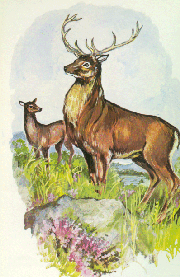








 



 |
 The
Red Deer (Fia Rua)--:The red deer is the largest of three type of deer in Ireland.
The deer is reddish brown in summertime, but in the wintertime it has a
darker and has a longer coat.
The male deer is called a stag, and the female deer is called a hind.
The baby is known as a calf and is born in early June.
It has a light brown fawn coat with flecked white spots. The baby deer
stays with his mother for one year. The
red deer is a protected animal in Ireland. The stag has large pointed antlers which begin to grow in the second year,
in April and are fully grown by August / September . They are shed every
April and a new pair grow immediately. The size increases each year,
reaching a maximum size at six to eight years. While they are growing the
antlers are covered with a soft skin tissue called velvet, which contains
a rich blood supply and provides necessary monerals for the antlers to
grow. When growth stops, the blood supply to the antlers is cut off and
the velvet dries. The stag removes the dried velvet by rubbing the antlers
against branches or shrubs. This is called fraying. Antlers on a fully
grown stag have from six to twelve or more points. A stag with twelve
points is called a royal stag. The
Red Deer (Fia Rua)--:The red deer is the largest of three type of deer in Ireland.
The deer is reddish brown in summertime, but in the wintertime it has a
darker and has a longer coat.
The male deer is called a stag, and the female deer is called a hind.
The baby is known as a calf and is born in early June.
It has a light brown fawn coat with flecked white spots. The baby deer
stays with his mother for one year. The
red deer is a protected animal in Ireland. The stag has large pointed antlers which begin to grow in the second year,
in April and are fully grown by August / September . They are shed every
April and a new pair grow immediately. The size increases each year,
reaching a maximum size at six to eight years. While they are growing the
antlers are covered with a soft skin tissue called velvet, which contains
a rich blood supply and provides necessary monerals for the antlers to
grow. When growth stops, the blood supply to the antlers is cut off and
the velvet dries. The stag removes the dried velvet by rubbing the antlers
against branches or shrubs. This is called fraying. Antlers on a fully
grown stag have from six to twelve or more points. A stag with twelve
points is called a royal stag.
Once upon a
time over a hundred year’s ago the red deer was plentiful and roamed
Ireland freely.
You can find them in counties Donegal Wicklow, Kerry,
and Killarney. The
development of towns and cities, spreading farmlands and reduction of
forests caused their numbers to fall, over hundreds of years. The Great
Famine (1845 - 1847) finished them off except in Killarney, in County
Kerry, which now has possibly the only truly native stock. Those in
Donegal and Wicklow were introduced from Scotland in the 19th. century. I
have never seen a red deer, but I would like to some day.
Brian
Kavanagh.
Back
|

 The
Red Deer (Fia Rua)--:The red deer is the largest of three type of deer in Ireland.
The
Red Deer (Fia Rua)--:The red deer is the largest of three type of deer in Ireland.